Absolute Versus Relative Changes in Cardiac Troponins in the Diagnosis of Myocardial Infarction: A Systematic Review and Meta-Analysis
- PMID: 35915617
- PMCID: PMC9338783
- DOI: 10.7759/cureus.27414
Absolute Versus Relative Changes in Cardiac Troponins in the Diagnosis of Myocardial Infarction: A Systematic Review and Meta-Analysis
Abstract
Ischemic heart disease (IHD) is one of the leading causes of death globally. Rapid diagnosis of myocardial infarction (MI) will enable earlier initiation of the treatment and improve patient outcomes. Practice guidelines for non-ST-elevation acute coronary syndromes by the American College of Cardiology (ACC)/American Heart Association (AHA) had listed the diagnostic performance of absolute versus relative changes in evidence gaps. We aimed to address this evidence gap by examining the diagnostic accuracy of absolute versus relative changes in cardiac troponins at various time intervals in diagnosing MI. Grey literature, conference abstracts, animal studies, and reports published before 2009 and in languages other than English were excluded. We included reports that investigated absolute or relative changes in highly sensitive cardiac troponin T (hs-cTnT) or sensitive/highly sensitive cardiac troponin I (s/hs-cTnI) assays after specific time intervals (1, 2, or 3 h) in patients presenting with symptoms suggestive of the acute coronary syndrome. After screening, we arranged the reports in 12 separate groups based on the variables for which the data was reported. Quality assessment of the diagnostic accuracy studies-2 (QUADAS-2) was used to assess the risk of bias in the included studies. The weighted summary area under the curve (AUC) was calculated for each pool. We then performed two-sided (or two-tailed) tests to compare independent receiver operating characteristic (ROC) curves. MedCalc version 20.106 (MedCalc Software Ltd., Ostend, Belgium) was used for all statistical analysis. We included eight reports with 23,450 patients in the meta-analysis. Weighted summary estimates and their respective 95% confidence intervals (CI) under random-effects model for ROC-AUC are as follows: absolute hs-cTnI at 1 h - 0.94 (95% CI: 0.922 to 0.959, p < 0.001); absolute hs-cTnT at 1 h - 0.921 (95% CI: 0.902 to 0.941, p < 0.001); absolute s/hs-cTnI at 2 h - 0.953 (95% CI: 0.926 to 0.980, p < 0.001); absolute hs-cTnT at 2 h 0.951 (95% CI: 0.940 to 0.962, p < 0.001); relative hs-cTnT at 2 h - 0.818 (95% CI: 0.733 to 0.903, p < 0.001); relative s/hs-cTnI at 2 h - 0.762 (95% CI: 0.726 to 0.798, p < 0.001); absolute hs-cTnI at 3 h - 0.967 (95% CI: 0.95 to 0.984, p < 0.001); absolute hs-cTnT at 3 h - 0.959 (95% CI: 0.950 to 0.968, p < 0.001); and relative hs-cTnT at 3 h - 0.926 (95% CI: 0.907 to 0.945, p < 0.001). P-values of comparison of absolute and relative changes are as follows: hs-cTnT at 1 h: <0.0001; hs-cTnI at 1 h: <0.0001; hs-cTnT at 2 h: 0.0024; s/hs-cTnI at 2 h: <0.0001; hs-cTnT at 3 h: 0.0022; and hs-cTnI at 3 h: 0.0005. Our analysis found absolute changes to be superior to relative changes in both hs-cTnT and s/hs-cTnI at 1, 2, and 3 h in the diagnosis of MI. There was no statistically significant difference in comparing s/hs-cTnI vs. hs-cTnT using absolute or relative changes at any time interval. Our findings suggest that future research investigating a potential 0 h/30 min algorithm should use absolute Δ over relative Δ. A suboptimal number of reports in the groups limited our ability to establish the robustness of the results. We did not receive any funding for this review.
Keywords: absolute change; cardiac troponin i; cardiac troponin-t; delta; high-sensitivity cardiac troponin (hs-ctn); myocardial infarction; non-st elevation myocardial infarction; relative change.
Copyright © 2022, Ravanavena et al.
Conflict of interest statement
The authors have declared that no competing interests exist.
Figures
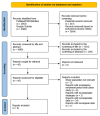
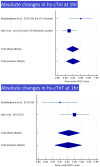
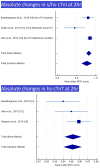
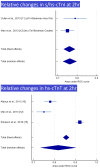
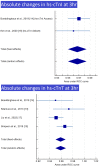


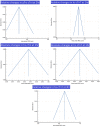

Similar articles
-
Early diagnosis of myocardial infarction using absolute and relative changes in cardiac troponin concentrations.Am J Med. 2013 Sep;126(9):781-788.e2. doi: 10.1016/j.amjmed.2013.02.031. Epub 2013 Jul 18. Am J Med. 2013. PMID: 23870791
-
Clinical Evaluation of a New High-Sensitivity Cardiac Troponin I Assay for Diagnosis and Risk Assessment of Patients with Suspected Acute Myocardial Infarction.Cardiology. 2021;146(2):172-178. doi: 10.1159/000512185. Epub 2021 Jan 18. Cardiology. 2021. PMID: 33461202 Free PMC article.
-
Direct comparison of high-sensitivity cardiac troponin T and I in the early differentiation of type 1 vs. type 2 myocardial infarction.Eur Heart J Acute Cardiovasc Care. 2022 Jan 12;11(1):62-74. doi: 10.1093/ehjacc/zuab039. Eur Heart J Acute Cardiovasc Care. 2022. PMID: 34195803
-
High-Sensitivity Cardiac Troponin I and T Kinetics Differ following Coronary Bypass Surgery: A Systematic Review and Meta-Analysis.Clin Chem. 2022 Dec 6;68(12):1564-1575. doi: 10.1093/clinchem/hvac152. Clin Chem. 2022. PMID: 36366960
-
High-sensitivity-cardiac troponin for accelerated diagnosis of acute myocardial infarction: A systematic review and meta-analysis.Am J Emerg Med. 2020 Jul;38(7):1402-1407. doi: 10.1016/j.ajem.2019.11.035. Epub 2019 Dec 28. Am J Emerg Med. 2020. PMID: 31932131
Cited by
-
Postoperative Myocardial Infarction after Non-Cardiac Surgery: An Update.J Clin Med. 2024 Mar 4;13(5):1473. doi: 10.3390/jcm13051473. J Clin Med. 2024. PMID: 38592265 Free PMC article. Review.
References
-
- The top 10 causes of death. [ May; 2022 ];https://www.who.int/news-room/fact-sheets/detail/the-top-10-causes-of-death 2020
-
- Fourth universal definition of myocardial infarction (2018) Thygesen K, Alpert JS, Jaffe AS, Chaitman BR, Bax JJ, Morrow DA, White HD. J Am Coll Cardiol. 2018;72:2231–2264. - PubMed
-
- 2014 AHA/ACC guideline for the management of patients with non-ST-elevation acute coronary syndromes: a report of the American College of Cardiology/American Heart Association Task Force on Practice Guidelines. Amsterdam EA, Wenger NK, Brindis RG, et al. J Am Coll Cardiol. 2014;64:0–228. - PubMed
-
- Diagnostic value of serial measurement of cardiac markers in patients with chest pain: limited value of adding myoglobin to troponin I for exclusion of myocardial infarction. Eggers KM, Oldgren J, Nordenskjöld A, Lindahl B. Am Heart J. 2004;148:574–581. - PubMed
-
- Introduction of high-sensitivity troponin assays: impact on myocardial infarction incidence and prognosis. Reichlin T, Twerenbold R, Reiter M, et al. Am J Med. 2012;125:1205–1213. - PubMed
Publication types
LinkOut - more resources
Full Text Sources
Research Materials
Miscellaneous
